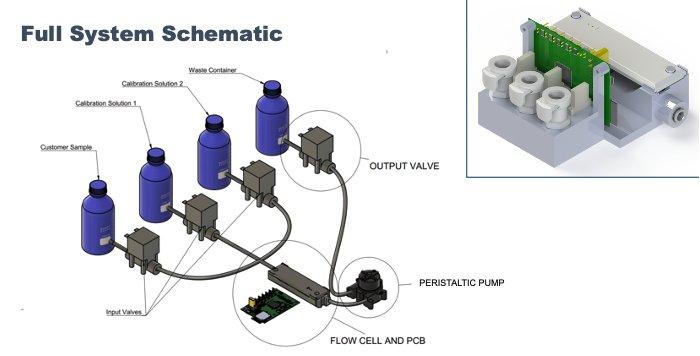Achieve water quality accuracy with real-time water-quality monitoring

Breaking News:
Kathmandu Nepal
Freitag, Mai 10, 2024

The severe detriments of lead contamination
The EPA has set the maximum contaminant level goal for lead in drinking water at zero because lead is a toxic metal that can be harmful to human health even at low levels. With nearly 412,000 deaths attributed to lead contamination annually in the United States, monitoring metal levels in water is a concern of life or death. There is no safe level of lead consumption for anyone. Lead is especially damaging for children and can damage developing brains leading to reduced intelligence quotient (IQ), attention span, impaired learning ability, and increased risk of behavioral problems. Prompt detection and remediation of any lead or other toxic contaminants in drinking water is imperative.
Rapid deployment of sensors integrated with network connectivity provide real-time actionable insight
Brewer Science fabricates a variety of printable sensor materials and deposits them onto a substrate utilizing processes such as physical vapor deposition (PVD) sputtering, screen printing, stencil printing, ink-jet printing, and high-speed jet dispensing. After fabrication, the resulting array is comprised of solid-contact ion-selective electrodes (SC-ISEs) for detecting analytes Pb2+, NO3-, and H+, along with a reference electrode and conductive pathways for measuring temperature and ionic conductivity. Brewer Science’s innovative water sensors are made possible by combining printed electronics with next-generation materials. The result is a continuous real-time monitoring platform capable of multisensing arrays and associated multifaceted sensor solutions. This system is incredibly adaptive and can be integrated and customized for use in numerous industries and applications.
Real-time actionable data is necessary to make preemptively make changes to ensure water quality is safe. Being able to make prompt and impactful decisions requires quantitative water quality measurement data presented in a dashboard that is easily communicated without specialized training, and enables a user to access the data remotely, in real time. This is achieved by using a hybrid integrated system consisting of printed electronic sensors interfaced with a software suite. The printed circuit board equipped with electrochemical methods, calibration solution, and sensor substrate connects to the software using either cloud-based through Wi-Fi network, Bluetooth, or USB.
Calibration in water quality monitoring is crucial for ensuring accuracy and reliability of the measurements. However, it can be a time-consuming, labor-intensive process to manually compare readings obtained from measuring instruments to a known standard or reference value. Using a smart integrated system equipped with a chemical flow of calibration solution is an efficient and reliable method to ensure each measurement is accurately reported. Calibration solution is incorporated into the system along with code-driven automation that prompts the chemical flow cell to take accurate measurements with up-to-date calibration.
Printed water sensors can be utilized in diverse monitoring environments
The versatility of the technology enables a wide range of applications, spanning from residential “smart water” applications to municipal wastewater reservoirs. With the small profile the sensor is not limited to strictly laboratory use, a challenge current detection systems face.
Source Water and Wastewater
Fresh Water Sources
Infrequent Wastewater Sources
Essential criteria when selecting a water sensor
With a wide range of applications in mind, Brewer Science offers a versatile solution specific to a customer-unique need. When selecting a water sensor, it’s important to consider the customer’s needs, intended application, and ensure the water sensor meets those anticipated needs. Some typical inquires to consider include,
Arrays for on-demand water-quality monitoring
For seamless implementation and successful integration, you need a provider that will not only create and calibrate the devices for you but assist in the entire process of ensuring the software meets the needs of your business and be accessible per your service requirements. Brewer Science has experience serving a diverse range of customers with unique business needs. This allows us to have a specialized approach to each customer’s requests and create a customized solution for your needs.
A successful water sensor application is comprehensive, both in its implementation and analytics
Brewer Science is committed to end-to-end solutions for our customers. We have been developing a sensing platform to interface with our sensors and deliver the measurements fully evaluated to our customers. The internet of thing (IOT) aspect of the water monitoring initiative includes:
Brewer Science has developed a full-service water sensing platform that starts with measurement at the sensor with custom electronics. Our printed circuit boards and firmware will apply electrochemical methods to the sensors and gather the data. From there we will supply the customer with an appropriate data transport solution from LAN network connections to cellular networks. Once the data is transported to the cloud our machine learning will quickly transform the raw data stream into a meaningful data set with reportable metrics. The software team will then provide the customer with a portal to view their measurements, see device health, and secure it all behind username and password access.
Brewer Science is focused on delivering critical, real-time information to our customers to achieve their goals, solve their problems, and improve their current systems. Brewer Science offers a full spectrum of services based on the customer’s need, ranging from materials development, electronics design, or a complete solution. You can learn more about Brewer Science printed electronics on our website. Or contact us if you’re interested in exploring arrays for on-demand water quality monitoring.
KGH Concepts GmbH
Oeder Weg 118-120
60318 Frankfurt am Main
Telefon: +49 (176) 61704139
Telefax: +49 (176) 61704139
http://www.techblick.com/
![]()